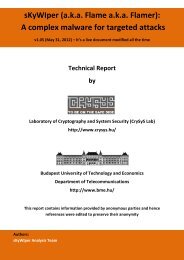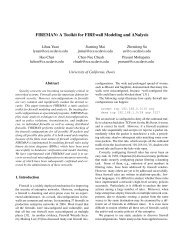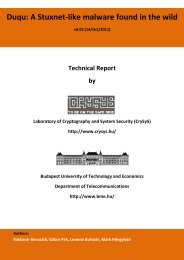You also want an ePaper? Increase the reach of your titles
YUMPU automatically turns print PDFs into web optimized ePapers that Google loves.
1. INTRODUCTION<br />
In the remainder part of this chapter, the three wireless networks I worked with within this<br />
dissertation are introduced.<br />
1.1 Introduction to RFID systems<br />
The following description of RFID systems and its security and privacy problems is based on [Juels,<br />
2006; Langheinrich, 2009; Peris-Lopez et al., 2006]. The interested reader can get a broader view<br />
and deeper understanding on RFID systems by reading the cited papers instead of only relying on<br />
this short introduction.<br />
RFID (Radio-Frequency IDentification) is a technology for automated identification of objects<br />
or people. An RFID system consist of simple Tags, Readers, and Backend servers. The tags carry<br />
unique identifiers. These unique identifiers are read by nearby Readers by radio communication.<br />
The Readers send the obtained identifiers to Backend Servers. The goal of an RFID system is the<br />
unique identification of the holders of the Tags.<br />
Example applications of RFID systems include smart appliances, shopping, interactive objects,<br />
or medication compliance. This list can be expanded to hundreds of scenarios [Wu et al., 2009;<br />
RFID, 2012].<br />
The main threats to privacy in RFID systems are tracking and inventorying. A tracking attacker<br />
can eavesdrop message exchanges in different parts of the network. If the system is not defended<br />
against such attacks, the attacker can link different message exchanges of the same user, hence<br />
can track the user. This is a very important concern in RFID systems, that is why this problem<br />
is discussed in Chapter 2 (the problem of tracking is actually not unique to RFID systems, and I<br />
will study it in a different context in Chapter 3, namely in vehicular networks).<br />
Inventorying is a specific attack against RFID systems. It relies on the assumption that in<br />
the near future, most of our objects will be tagged with distant readable RFID tags. An attacker<br />
carrying out an inventorying attack can get know exactly what a user wears, has in her pockets or<br />
bag without the consent of the user.<br />
In Chapter 2, two private authentication methods are given, which make it difficult for an<br />
attacker to carry out tracking and inventorying attacks.<br />
Another important field of security problems regarding RFID is the authenticity of the tags. In<br />
short, the privacy problem is related to malicious readers, while the authenticity problem is related<br />
to malicious tags. The main problem is that illegitimate tags can be counterfeited to obtain the<br />
same rights as the legitimate tag holds. In the following, I will assume the presence of malicious<br />
readers, but no malicious tags is considered.<br />
When considering the RFID tags capabilities, the tags on the market can be classified into two<br />
main categories: basic tags with no real cryptographic capabilities and advanced tags with some<br />
symmetric key cryptography capabilities.<br />
Basic tags<br />
Basic RFID tags lack the resources to perform true cryptographic operations. The lack of cryptography<br />
in basic RFID tags is a big impediment to security design; cryptography, after all, is the<br />
main building block of data security. The main approaches to provide privacy to basic tags are the<br />
following: killing, sleeping, renaming, proxying, distance measurement, blocking, and legislation.<br />
Killing and sleeping are very similar approaches. The basic idea is that an authenticated<br />
command can reversibly or permanently switch off the tag.<br />
Another approach is to divide the identifier space into two separate parts by a modifiable<br />
privacy bit [Juels et al., 2003; Juels and Brainard, 2004]. The two parts are the private and the<br />
public parts. A blocker device can make the scanning of private tags infeasible, and the tags can<br />
be moved between the public and private zone on demand. Another device based solution is the<br />
proxying, where the holder of the tag can use some equipments (like a mobile phone)to enforce<br />
privacy [Floerkemeier et al., 2005; Juels et al., 2006; Rieback et al., 2005].<br />
2












